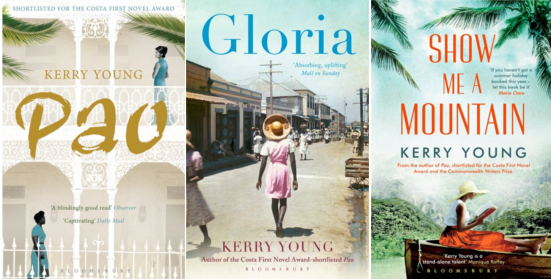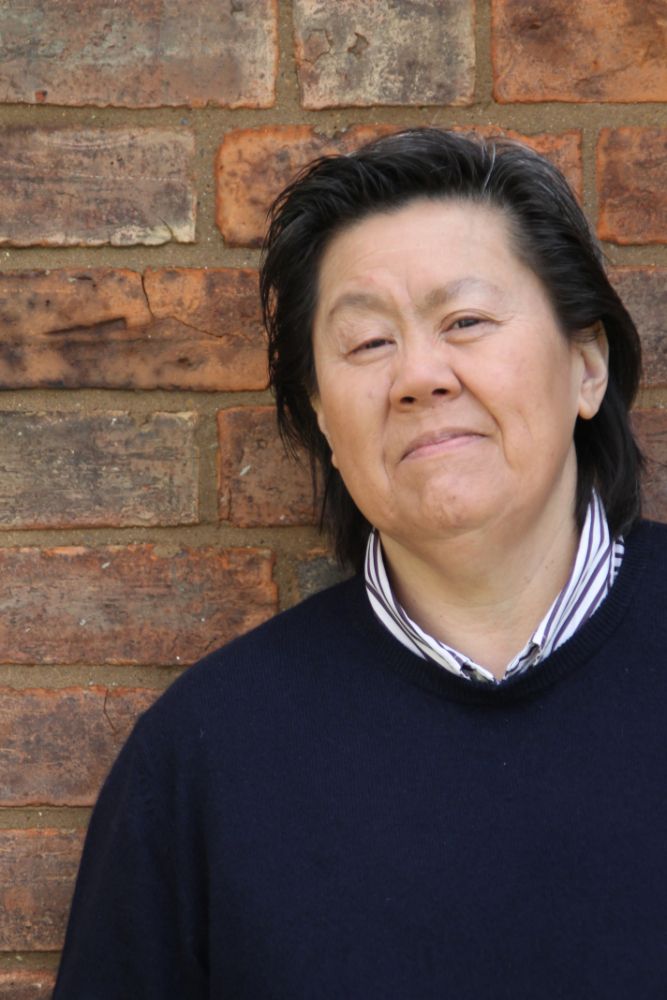Author Kerry Young discusses her three interlinking novels, and the role her writing plays in bringing to light an under-represented group in fiction.

Pao, Gloria and Show Me A Mountain are three interlinked novels set in Jamaica against a backdrop of political upheaval, economic crisis and social change from the civil disturbances of 1938; through Independence and the turbulent 1960s; the violence and mass migration of the 1970s; and the acquiescence of the early 1980s.
Each book is a stand-alone story covering the same period of time in the lives of three main characters, Yang Pao, Gloria Campbell and Fay Wong. You can read each book on its own or in connection with the other two, in any order.
My idea from the beginning was to write a commentary on Jamaica’s contemporary political history. My version of it anyway. Not that I wanted to change the facts or re-write history but rather that I wanted to make my Chinese Jamaican characters visible and show how our lives in Jamaica dated back over 150 years; why and when we went to Jamaica; and how we helped to build a nation alongside the African Jamaicans who had been brought originally as slaves, Indian indentured labourers, Lebanese traders, Jewish merchants and poor working whites. I wanted to show people living through dramatic social and political challenges, adapting and re-configuring their lives and importantly, coming to their own point of view. Their own take on what it meant to be Independent after 300 years of British rule. Centrally, I wanted to reflect on what it meant to be part of a minority Chinese community in a majority population increasingly vocal and insistent about its African roots and heritage. And why, as a result of this experience, our national motto ‘Out of Many, One People’ is so important to every Jamaican.
I was motivated by the awareness that most people in Britain know nothing of the Chinese in Jamaica. Not like in Toronto or Florida where so many Chinese Jamaicans settled during the 70s and beyond. When the British think of Jamaicans they imagine dark-skinned Africans who arrived on the Empire Windrush in 1948 seeking a better life in a promised land. Bringing with them Caribbean food and calypso music and carnival. They don’t think of the other Jamaicans who fled for freedom, perhaps for political or economic reasons; to escape mistreatment or the confines of social mores or family expectations; or even to pursue their art. In fact, when we were trying to sell Pao there were quite a few editors who were skeptical. ‘Chinese in Jamaica?’ they asked. 'How authentic is that?'
After Pao was published I started to receive emails from readers all over the world. Mostly from the USA and Canada, but also from Australia and Jamaica, expressing delight about being recognised. Finally. We existed. Chinese Jamaicans.

But not satisfied with one book, I decided to make my life harder. Why? Because there is never one truth or reality. Pao was Chinese. Gloria was of African heritage. Fay was mixed African and Chinese. And that meant they lived in three different Jamaicas, certainly between 1938 and the early 1980s. They lived in three different sets of circumstances, with three different histories, and three different possibilities for their futures. Telling that story in all its complications and contradictions was no mean feat.
Writing your first novel is tough work. But you do it in your own time, to the beat of your own drum, according to your own conscience and if you never finish it no one is any the wiser. When you are faced with writing a second that’s a different matter. Now you have an editor. Now you have a deadline. Now you have expectation. And to make the situation worse for myself, I’d set an even bigger challenge – to write a second book set in the same place, over the same period of time, involving the same main characters.
The task seemed daunting. There were so many things to get right and reconfigure. It was like setting to work on a massive jigsaw puzzle of character backstories and trajectory; timing/chronology/synchronisation; explanations for incidental observations, events and sub-plots I’d included the first time around without knowing how they fitted into a story that was now growing into a wider, deeper, interwoven latticework. But the hardest part was how to retell that same period of Jamaica’s turbulent history from a different perspective, especially since I’d already used all the (essential) facts in the first book.
Yet somehow I managed it. And not satisfied, sought out more punishment by deciding to do it for a third time. The jigsaw became a Rubik’s Cube.
All three books chart Jamaica’s journey and reflect on how people’s lives were shaped by their experience and responses to the circumstances in which they found themselves. For as Karl Marx observed people “make their own history, but they do not make it as they please; they do not make it under self-selected circumstances, but under circumstances existing already, given and transmitted from the past.”
Pao, Gloria and Fay must find their redemption. Pao must reconcile his love for the poor, dark-skinned Gloria with his longing for the privilege of his wealthy light-skinned wife, Fay. Gloria must forgive herself for the wounds and shame of a past that is never far behind. Fay must find the peace and sense of self that has always eluded her. All three of them must confront their pre-existing circumstances and try to do their best.
Kerry Young was born in Kingston, Jamaica, to a Chinese father and a mother of mixed Chinese-African heritage. She moved to England in 1965 and lives in Leicestershire. Kerry is a Reader for The Literary Consultancy and a tutor for the Arvon Foundation. She is also Honorary Assistant Professor in the School of English at The University of Nottingham and Honorary Creative Writing Fellow at the University of Leicester. She was writer-in-residence at The University of Sheffield (2014-2016) as a part of the Royal Literary Fund Fellowship Programme. Visit her website here and check out Kerry's books on Bloomsbury.com
Comments